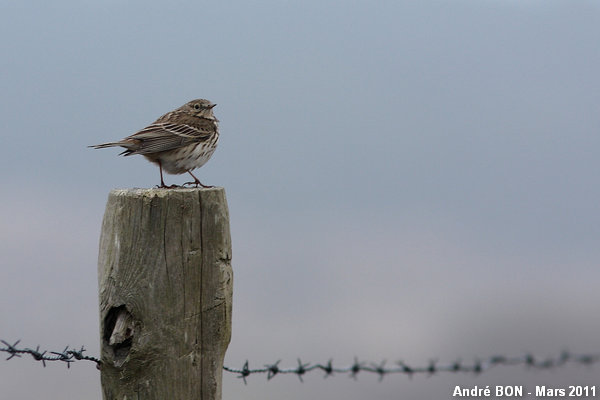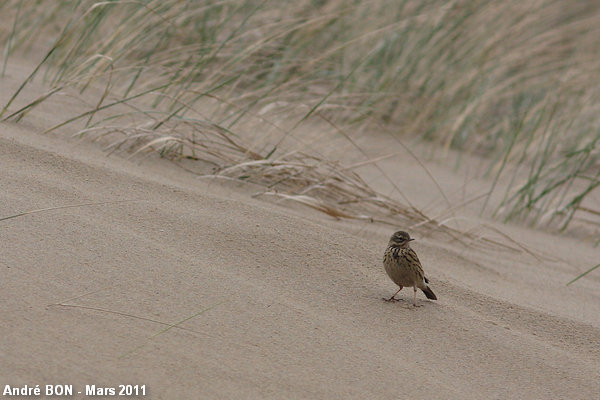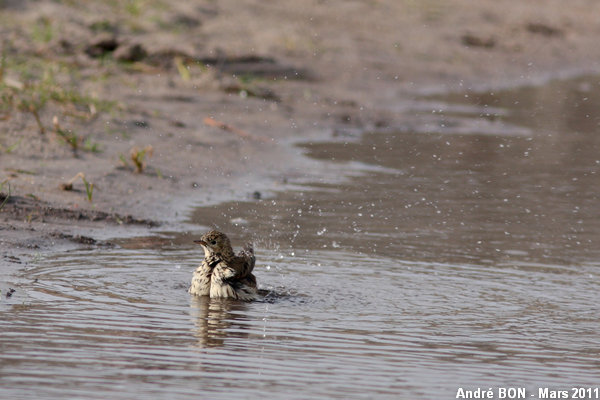



| Meadow Pipit (Anthus pratensis (Linnaeus, 1758)) |




|
|
Scientific name: Anthus pratensis (Linnaeus, 1758) Common name: Meadow Pipit French name: Pipit farlouse, Pipit des prés. Order: Passeriformes Family: Motacillidae Size: Body size: 14 to 15 cm; Wingspan: 22 to 25 cm; Weight: 16 to 25 g. Habitat: Fresh, open and damp habitats. Damp meadows, marshes, costal zones. It is also found in cultivated areas. Food: Larvae, insects, spiders and small molluscs. It also feeds on seeds of various grasses and other plants, especially in winter. Nesting: The female builds a cup-shaped nest on the ground. It is hidden under a grass tuft or a rush tuft. There are often two broods of 4 to 6 eggs between May and June. Migration: In winter, the Meadow Pipits move southwards to southern Europe, North Africa or south-western Asia. Some birds over winter on the western European coasts. Geographic area: Europe, Greenland an Island, North Africa, Asia except south east. The populations are more important in the northern regions during the breeding season. |
The Meadow Pipit is a small terrestrial bird which sometimes lands on the top of a bush, on the top of a pole or on a fence to better detect any eventual predator. The upper side is dark brown and streaked. The main colour is a little greenish. The chest and the lateral sides are yellowish. They show dark patches which form streaks which do not get thinner at the rear. The head shows a pale moustache stripe. The legs are pale pinkish brown. The hind claw has a remarkable length which exceeds the length of the toe on which it is. The Tree Pipit (Anthus trivialis) shows a stronger bill. The yellow moustache stripe is wider. The upper side is a more uniform colour and the lateral streaks on the underside get very thinner at the rear. The Red-throated Pipit (Anthus cervinus) is very similar to the Meadow Pipit when in inter nuptial plumage. However its back is more contrasted, its rump is darker and the lateral streaks on the underside are wider and sharper. In nuptial plumage its red throat avoid any confusion. The Eurasian Rock Pipit (Anthus petrosus) and the Water Pipit (Anthus spinoletta) have darker legs. |
| [To know more about the Meadow Pipit] [Next picture] [Top] |

|
The rather contrasted back and the wide streaks on the underside made me a little hesitate with the Red-throated Pipit. However I think that a Red-throated Pipit would be in nuptial plumage at this date. That's why I think that this one is a Meadow Pipit. |
| [To know more about the Meadow Pipit] [Next picture] [Previous picture] [Top] |

|
Here is the same bird as above which slowly moves away while I am trying to approach under a grey and rainy weather. |
| [To know more about the Meadow Pipit] [Next picture] [Previous picture] [Top] |

|
I have often observed Pipits on the ground in the sand dunes during my very short stay in the northern part of the Netherlands. |
| [To know more about the Meadow Pipit] [Previous picture] [Top] |

|
The bath. |